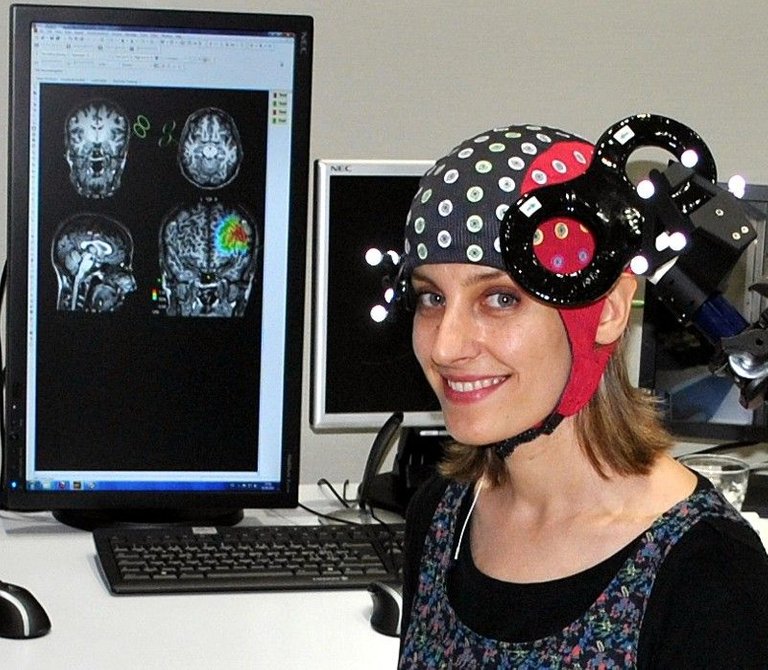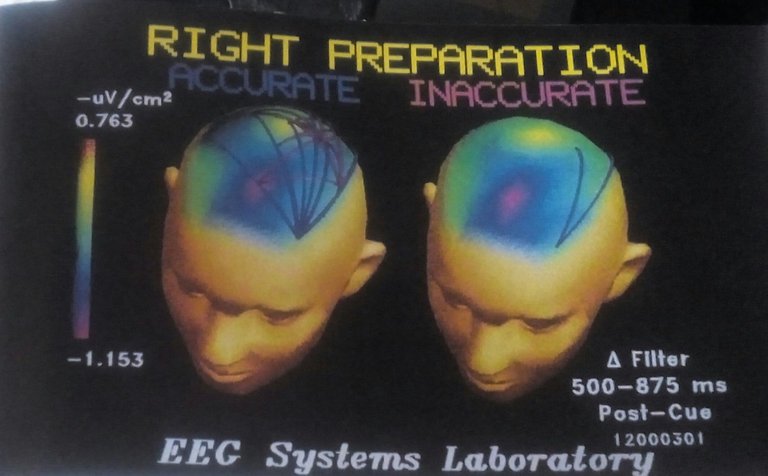To think any kind of thought is to activate an entire network of nerve cells in the brain.
The brain is dynamic, always active, and always changing. Dr. Alan Gevins, of EEG Systems laboratory in San Francisco, studies the Brian while it is working and is able to produce spectacular images of the process of thinking.
 Source[UZH-Laboratory For Social & Neural Systems Research(SNS Lab) - EEG
Source[UZH-Laboratory For Social & Neural Systems Research(SNS Lab) - EEG
Gevins describes what goes on when a test subject makes a simple finger movement. "We measure just those signals in the brain that are related to the finger pressure task, while making all the other signals of the brain basically disappear".
The subjects wear a hat full of electrodes. Their task is to press a button, either lightly or with more force, when numbers are shown on the the screen before them. The entire task requires about four discrete thoughts. Signs of each thought can be measured through the electrodes and converted into a visual image.
Gevins likens these images to the shadows cast on the walls of Plato's caver: "The shadows of the actors who were dancing. Well, these are the shadows of thoughts. They're not the thoughts themselves, but you may say they're the low - resolution image of the traces made by thoughts cast off that the brain is changing even as our thoughts are changing. When a subject prepares to respond with a finger movement, for instance, the left prefrontal cortex may send signals back to alert areas involved in the vision, touch, and fine motor control. These are physical signs of simple versions of the mental models we form when we navigate, play chess, solve problems.
"Perception isn't a passive process"
Gevins notes, "where stimuli come from the environment and impinge on our sensory organs. Perception is a very active, probing process. I have an idea in my mind. I probe the environment. I move my eyes around. I tune my hearing. I look for information. I compare that information with the model in my mind. And then I might take some action."
Our mental models change from moment to moment, depending on our expectations and experience. If a person wakes up in a strange city and thinks for a moment that he's at home in his own bed, he has to revise that mental model."In such an experience," says Gevins, "I have to instantly re-form my mental model to take into account that I'm in a strange room in a strange hotel in a strange city. In order to do this, functional neuronal networks will have to be reconfigured. We interpret the world through our mental models. In a sense we create reality in our brains and our minds. To a large extent, we see what we expect to see. We hear what we expect to hear. There is an interaction, a negotiation, between our expectations and what's really going on out there." And he emphasizes, "If we have any hope at all of getting some insights into human behaviour, human thought, the human mind, we've got to see the whole system functioning, and in near real time. It's not going to do us any good to see one or two neurons firing; it's the integration of all these pieces that produces our behaviour and our thoughts"
Nothing resembling this exist within computers, which is one of the reasons why a six month-old child can recognize her mother while a computer capable of specific facial recognition is only the stuff of science fiction. To phrase it slightly differently, our brain, over our life time, works as a self-assembling structure whose functional capacities are distributed. That means, in practical terms, that we when one part breaks down, another part can often be recruited to take its place.
"I can't remember the name of the store where I bought this shirt but I can tell you exactly how to get there from here" We may say to a friend when we can't remember the name of the store. "Graceful degradation" is the intriguing term for this loss of clarity and precision. We exhibit it or rather our brains do, but computers don't. A computer either comes up with the specific information requested or it doesn't.
 Dr. Alan Gevins of EEG Systems Laboratory in San Francisco uses an advanced EEG imaging system to display thought process pathways. Here, different pathways were activated when the subject was alerted beforehand to respond to a number shown on a video screen, and when the subject had no advance preparation. In addition to the sharp difference in pathways, the response was accurate with preparation, and inaccurate without it, suggesting that even brief advance warning can help avert errors.
Dr. Alan Gevins of EEG Systems Laboratory in San Francisco uses an advanced EEG imaging system to display thought process pathways. Here, different pathways were activated when the subject was alerted beforehand to respond to a number shown on a video screen, and when the subject had no advance preparation. In addition to the sharp difference in pathways, the response was accurate with preparation, and inaccurate without it, suggesting that even brief advance warning can help avert errors.
This is because brains but not computers are good at employing alternative neuronal networks to signify the same thing. Cell assemblies make this possible. If a sufficient number of cell assemblies are coupled together, generalizations become possible that are beyond all but the most advanced computers. For instance, we recognize a Chippendale chair, a pew, a tree stump, and an empty mineral crate as things to sit on. This recognition is based on many cell assemblies for the abstract concept, "Some thing to sit on."
These cell assemblies are also responsible for humour, insight, inspiration, and creativity. The brain can cross-reference ideas and concepts that at first seem to have nothing in common. "Brainstorming" is an apt term for the process of getting together with others and letting the "creative juices" flow without inhibitory restrains.
Thank you for taking the time to read this post
I am George Ani
@georgeani

Scan...
This topic is serious ooo.
Well researched post. Some references and image sourcing are in order. Upvoted!